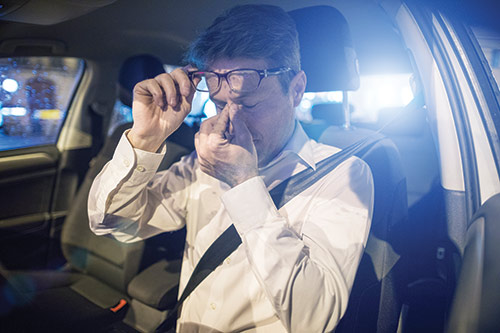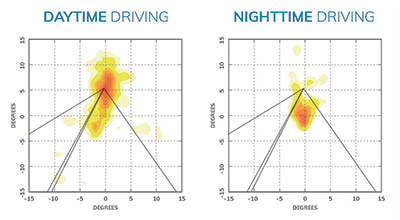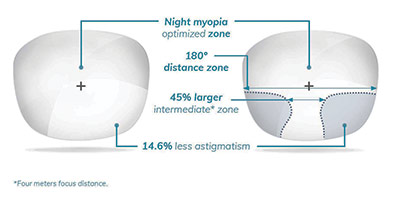
Sponsored by IOT
By Deborah Kotob, ABOM
I love driving at night, said no one ever!
We face many visual challenges with night driving. For starters, 1 in 3 of us have a condition called night myopia. Night myopia is a change in refraction in dim illumination that decreases distance acuity. Even those with normal distance vision can experience night myopia. Another factor contributing to poor nighttime driving vision is the inability to focus all wavelengths on the retina (chromatic aberration). Short-wavelength blue tends to focus in front of the retina, leading to distortions.
Nighttime driving requires mesopic vision. Mesopic vision means that we use a mix of our Rod and Cone retinal photoreceptors cells to see in low light environments. In our modern world, most nighttime activities including driving are illuminated enough for mesopic vision. Mesopic light conditions are not optimal for good vision, and the increased glare and rapidly changing light levels make night driving all the more challenging. Hence, no one has ever said they love driving at night—certainly no one over 40.
“Driving is a complex task that requires specific visual skills and optimal vision to clearly see and react to traffic signals, traffic lights, pedestrians and other vehicles. The nighttime driving environment presents challenging visual conditions for drivers, including dim street lighting, glare from oncoming headlights and the need to quickly adapt across a wide range of lighting levels, inducing changes in visual perception such as loss of visual acuity, increased glare or night myopia. Also, fixation changes during day and night driving conditions. At nighttime, the area of fixation is smaller than in daytime driving, and the eye tends to fixate lower.” (iovs.arvojournals.org)
To address the challenges of driving, particularly at night, IOT designed inMotion, a free-form single vision and progressive lens to improve day and night driving.

FIG. 1 Above are the gaze fixation maps of different driving conditions according to the study lead by Brimley et al., these differences can be attributed to reduced visibility and reliance on car headlights at night.
ADAPTED TO NIGHT DRIVING: 90 percent of a driver’s reaction time depends on vision. Standard progressive lenses can make it uncomfortable to drive, having an inadequate distance visual field or limited peripheral vision. By analyzing the visual needs of drivers, the inMotion progressive lens was developed to maximize intermediate*distance vision, which are the areas most used for driving. It offers optimized vision of the road, dashboard and mirrors.
In the study titled “Mesopic Visual Function Attained by Lenses Specifically Designed for Night Driving,” mesopic visual function of users wearing general-use lenses and lenses optimized for mesopic vision were compared. The study is conducted by IOT Scientists Chamorro, E*, Cleva, JM*, Alvarez, M*, Subero, M*, Garcia-Ortega, M*, Alonso, J* *Indizen Optical Technologies S.L., Spain Corresponding author Eva Chamorro 5935 - A0432.

FIG. 2
STUDY METHOD
56 subjects participated in this observational, prospective and double-blind trial. Visual function in mesopic illumination conditions after 15 minutes of dark adaptation was evaluated while users were wearing two different lenses:
- Control lens: General-use design with standard power distribution and standard anti-reflective coating.
- Test lens: Special design developed ad-hoc for this study and characterized by a region with a slight negative defocus above the fitting cross and a special blue light filter.
Participants under 45 years of age tested single vision lenses (group 1, n=26) and subjects over 45 years of age tested progressive lenses (group 2, n=30). The parameters analyzed were: Low-contrast undistorted distance visual field using a rotational platform, glare recovery time after flash, subjective satisfaction (scale 1-5) after participants used both pairs of lenses for seven days, the preferred design for driving. Statistical analysis was performed using Statgraphics Centurion XVI.II software.
STUDY RESULTS
A lower glare recovery time after flash, as well as a significantly higher satisfaction, was observed for group 2 (people over 45) with the special design. For both groups, low-contrast and an undistorted visual field were significantly wider with the special design. The specially designed lens for mesopic vision was preferred for driving in both age groups.
STUDY CONCLUSIONS
A new lens-design concept characterized by special power distribution maps and incorporating a blue light filter improves mesopic visual function. These lenses provided a wider undistorted distance visual field, lower glare recovery time and higher user satisfaction in general, and specifically for driving.
Summary: Our reaction time is integrally linked to good vision. Lenses that improve vision while driving, including nighttime driving, are lenses with real benefits for both the young and the elderly. Forty-three percent report that they feel insecure driving at night due to loss of visual capacity. Solve this problem and be your patients’ eyecare hero.
Part 1: The Effect of Oblique Astigmatism on PAL
Part 2: Objective measures and subjective measures used by IOT in analyzing lens design performance
Part 3: Bumping the Add Power in PALs













